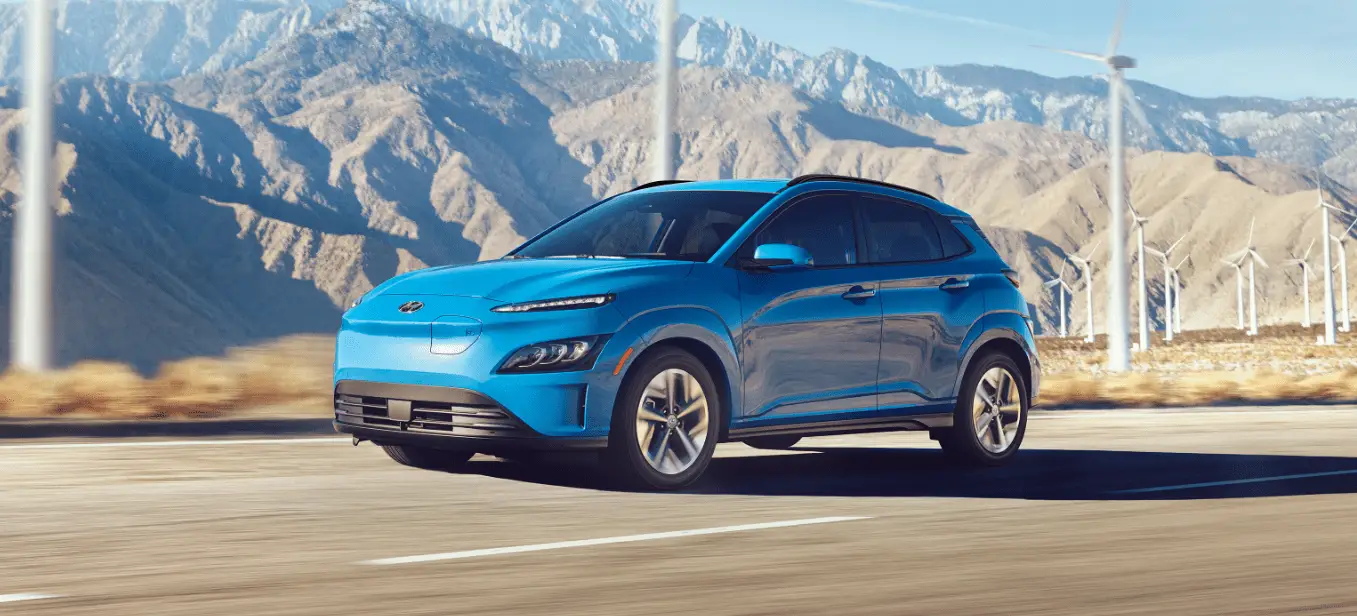2023 Hyundai Kona-EV Driving and Operating Information
The 2023 Hyundai Kona-EV is an electric SUV that can go 258 miles on a single charge, according to the EPA. To turn it on, you have to fully press the brake pedal and then press the START button. To drive, all you have to do is press the gas pedal to go faster and the brake pedal to slow down or stop. The Kona-EV can be charged at any public charging point. Using a Level 1 charger takes about 25 hours, a Level 2 charger takes about 9 hours, and a DC fast charger takes about 50 minutes. The Kona-EV comes with several safety features as standard, such as forward collision warning with automatic emergency braking, lane departure warning with lane keeping assist, blind spot monitoring, back cross-traffic alert, and adaptive cruise control.
2023 Hyundai Tuscon Specs, Price, Features, Milage (Brochure)
Driving and Operating Information
How to Start the Vehicle
- Holding the smart key, sit in the driver’s seat.
- Fasten the seat belt before starting the vehicle.
- Make sure to engage the parking brake.
- Turn OFF all electrical devices.
- Make sure to depress and hold the brake pedal.
- While depressing the brake pedal, shift to P (Park).
- Depress and hold the brake pedal while pressing the Start/Stop button.
- When the “ ” indicator is ON, you can drive the vehicle.
When the “ ” indicator is OFF, you cannot drive the vehicle. Start the vehicle again. - Depress and hold the brake pedal and shift to the desired position.
Information
While the charging cable is connected, the gear cannot be shift from P (Park) to any other gear for safety reasons. - Release the parking brake and slowly
release the brake pedal. Check if the vehicle slowly moves forward, then depress the accelerator pedal.
How to Stop the Vehicle
- Hold down the brake pedal while the vehicle is parked.
- While depressing the brake pedal, shift to P (Park).
- While depressing the brake pedal, engage the parking brake.
- While depressing the brake pedal, press the Start/Stop button and turn off the vehicle.
- Check if the “ ” indicator is turned OFF on the instrument cluster.
When the “ ” indicator is ON and the gear is in a position other than P (Park), the driver can accidentally depress the accelerator pedal, causing the vehicle to move unexpectedly.
Virtual Engine Sound System
The Virtual Engine Sound System generates engine sound for pedestrians to hear vehicle sound because there is no sound while the Electric Vehicle (EV) is operating.
- If the vehicle is in the ready ( ) mode and the gear is not in P (Park), the VESS will be operated.
- When the gear is shifted to R (Reverse), an additional warning sound will be heard.
CAUTION
- The vehicle is much quieter while driving than a conventional gasoline-powered vehicle. Be aware of your surroundings and always drive safely.
- Check if there is something behind the vehicle when driving in reverse. Pedestrians may not hear the sound of the vehicle.
Distance to Empty
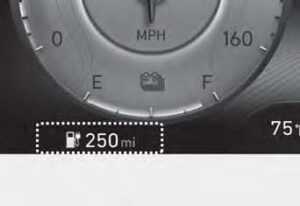
The location of where the vehicle range is displayed is different depending on which drive mode is active.
For more details, refer to “Drive Mode System” in chapter 5.
When the destination is not set
- On average, a vehicle can drive about 250 miles (400 km). Under certain circumstances where the air conditioner/heater is ON, the range is affected, resulting in a possible distance range from 210~250 miles (335~400 km). When using the heater during cold weather or driving at high speed, the high voltage battery consumes a lot more electricity. This may reduce the range significantly.
- After “—” has been displayed, the vehicle can drive an additional 2~5 miles (3~8 km) depending on driving speed, heater/air conditioner, weather, driving style, and other factors.
- The range that is displayed on the instrument cluster after completing a recharge may vary significantly depending on previous driving patterns.
When the previous driving patterns include aggressive or high-speed driving (for example, predominantly highway miles, etc.), the estimated range on the next full charge will be lower than normal.
When the previous driving patterns are predominantly mild or economical (for example, city driving), the estimated range on the next full charge will be increased. - The calculated range may depend on many factors such as the charge amount of the high-voltage battery, weather, temperature, durability of the battery, geographical features, heater/air conditioning use and driving style. When the ambient temperature is low such as in winter, the actual driving distance may
be reduced due to battery cold temperature effects. - Natural degradation may occur with the high voltage battery depending on the number of years the vehicle is used. This may reduce the vehicle range.
Navigation – when a destination is set
When a destination is set using the vehicle navigation system (if equipped), the vehicle range may change. The vehicle range is recalculated using the destination route information. While driving, the range may vary based on traffic conditions, driving patterns and vehicle settings, etc.
Tips for Improving Range When Using the Climate Control System
- Operating the climate control system consumes electrical energy from
the EV battery. Continuous use may reduce the vehicle range.
When using the climate control system, it is recommended to set the control to 72°F (22°C) AUTO. The climate control system has been optimized to operate at this setting for maximum comfort and efficiency. - When possible, use the DRIVER ONLY feature on the climate control system. This will discontinue airflow to the passenger side and reduces climate control power consumption.
Tips for Improving Range While Driving
- Depress and hold the accelerator pedal to maintain speed and drive economically.
- Gradually depress and release the accelerator pedal when accelerating or decelerating.
- Always maintain specified tire pressures.
- Do not use unnecessary electrical components while driving.
- Do not load unnecessary items in the vehicle.
- Do not mount parts that may increase air resistance.
- Set regen to a higher level 1-2 using the steering wheel paddles.
Power/Charge Gauge
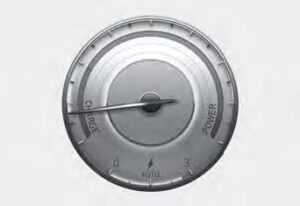
- The Power/Charge Gauge shows the energy consumption rate of the vehicle and the charge/discharge status of the regenerative brakes.
- POWER :
This portion of the gauge indicates the amount of electrical power supplied to the EV motor while driving. - CHARGE :
This portion of the gauge indicates the amount of charging to the EV battery when regenerative braking is applied.
State of charge (SOC) gauge for high voltage battery
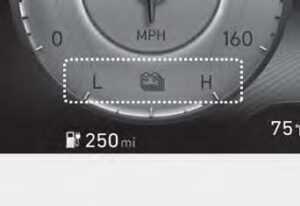
- The SOC gauge shows the charging status of the high-voltage battery.
- “L (Low)” position on the indicator indicates that there is not enough energy in the high-voltage battery. “H (High)” position indicates that the driving battery is fully charged.
- When driving your vehicle for long distances on the highway or in rural areas, make sure to check that the State of Charge (SOC) is sufficient to get to your destination and make sure to map out useable charging locations along your route.
NOTICE
When there are 1-2 gauge bars left for the high voltage battery, the vehicle speed is limited and then eventually the vehicle will turn OFF. Charge the vehicle immediately.
Warning and Indicator Lights (related to electric vehicles)
This indicator illuminates:
When the vehicle is ready to be driven.
- ON: Normal driving is possible.
- OFF: Normal driving is not possible, or a problem has occurred.
- Blinking: Emergency driving.
When the ready indicator goes OFF or blinks, there is a problem with the system. In this case, have your vehicle inspected by an authorized HYUNDAI dealer.
Service Warning Light
This warning light illuminates:
- When the Start/Stop button is in the ON position.
- It illuminates for approximately 3 seconds and then goes off.
- When there is a problem with related parts of the electric vehicle control system, such as sensors, etc.
When the warning light illuminates while driving, or does not go OFF after starting the vehicle, have your vehicle inspected by an authorized HYUNDAI dealer.
LCD Display Messages

This message is displayed if you connect the charging cable without the gear in the P (Park) position.
Shift to P (Park) before connecting the charging cable.
Remaining time

This message is displayed to notify the remaining time to charge the battery to the selected target battery charge level.
Unplug vehicle to start

This message is displayed when you start the vehicle without unplugging the charging cable. Unplug the charging cable, and then turn on the vehicle.
This message is displayed when you attempt to shift the vehicle out of P (Park) with the charging door open. You must close the charging door before driving the vehicle.
Charging Stopped. Check the AC/DC charger/Charging stopped. Please check the AC/DC charger

- This warning message is displayed when charging is stopped for the reasons below:
- There is a problem with the external AC charger or DC charger
- The external AC charger stopped charging
- The charging cable is damaged
Charging Stopped. Check the cable connection/Charging interrupted. Please check the cable connection

This warning message is displayed when charging is stopped because the charging connector is not correctly connected to the vehicle charging port.
If this message is displayed, disconnect the charging cable from the vehicle charging port and reconnect it. Before reconnecting, check to make sure there is no foreign debris or damage to the connector or charging port on the vehicle.
If the same problem occurs when charging the vehicle with a replaced charging cable or genuine HYUNDAI portable charger, have your vehicle inspected by an authorized HYUNDAI dealer.
Check regenerative brakes/Stop vehicle and check regenerative brakes

This warning message is displayed when the regenerative brake system does not work properly.
If this warning message is displayed, have the vehicle inspected by an authorized HYUNDAI dealer.
Low EV battery

When the high voltage battery level reaches below approximately 8%, this warning message is displayed.
The warning light on the instrument cluster ( ) will turn ON simultaneously.
Charge the high-voltage battery immediately.
Charge immediately. Power limited

When the high voltage battery level reaches below approximately 5%, this warning message is displayed.
The warning light on the instrument cluster ( ) and the power down warning light ( ) will turn on simultaneously.
The vehicle’s power will be reduced to minimize the energy consumption of the high-voltage battery. Charge the battery immediately.
Power limited due to low EV battery temperature. Charge battery/Low outside temperature may limit power output. Charge EV battery

Both warning messages are displayed to protect the electric vehicle system when the outside temperature is low. If the high voltage battery charging level is low and parked outside in low temperature for a long time, vehicle power could be limited.
Charging the battery before driving helps increase power.
NOTICE
If this warning message is still displayed even after the ambient temperature has increased, have the vehicle inspected by an authorized HYUNDAI dealer.
Energy Flow
The electric vehicle system informs the drivers its energy flow in various operating modes. While driving, the current energy flow is specified in three modes.
Vehicle stop
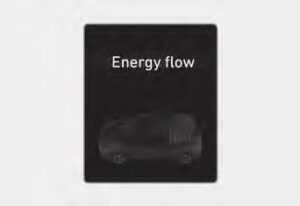
The vehicle is stopped.(No energy flow)
EV propulsion

Only the motor power is used to drive the vehicle.
Regeneration

The high-voltage battery is charged up by the regenerative brake system.
Aux. Battery Saver
The Aux. Battery Saver+ is a function that monitors the charging status of the 12 V auxiliary battery.
If the auxiliary battery level is low, the main high-voltage battery charges the auxiliary battery.
Information
The Aux. Battery Saver+ function will be ON when the vehicle is delivered. If the function is not needed.
Mode
- When the Start/Stop button is in the OFF position with all doors, hood and liftgate closed, the Aux. Battery Saver+ periodically activates according to the auxiliary battery status.
- Automatic Mode :
When the Start/Stop button is in the ON position with the charging connector plugged in, the function activates according to the auxiliary battery status to prevent over discharge of the auxiliary battery.
Information
- The Aux. Battery Saver+ activates for a maximum of 20 minutes. If the Aux Battery Saver+ function activates for more than 10 times consecutively in automatic mode, the function will be disabled. (Note: There may be
a problem with the 12V auxiliary battery.)
If the vehicle is driven normally and 12V battery can charge normally, the Aux. The Battery Saver+ function will be enabled again. - The Aux. Battery Saver+ function cannot prevent battery discharge if the auxiliary battery is damaged, worn out, used as a power supply or unauthorized electronic devices are used.
- If the Aux. Battery Saver+ function was activated, the high voltage battery level may have decreased.
WARNING
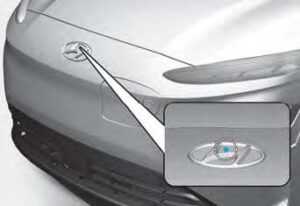
When the function is activated the indicator lamp will illuminate and high-voltage electricity will be flowing in the vehicle. Do not touch the high-voltage electric wire (orange), connector, and all-electric components and devices. This may cause electric shock and lead to injuries. Also, do not modify your vehicle in any way. This may affect your vehicle performance and lead to an accident.
2023 Hyundai Tuscon Specs, Price, Features, Milage (Brochure)
Safety Precautions for Electric Vehicles
If an Accident Occurs
WARNING
- When a vehicle accident occurs, move the vehicle to a safe place, turn OFF the vehicle and remove the auxiliary battery (12 V) terminal to prevent high-voltage electricity from flowing.
- If electric wires are exposed from inside or outside the vehicle, do not touch the wires.
Also, do not touch the high-voltage electric wire (orange), connector, and all-electric components and devices. This may cause electric shock and lead to injuries. - When you suspect leakage of inflammable gas and other harmful gases, open the windows and evacuate to a safe place. If any leaked fluid comes in contact with your eyes or skin, immediately clean the affected area thoroughly with tap water or saline solution and have doctors inspect it as soon as possible.
- When a vehicle accident occurs and the high voltage battery is damaged, harmful gas and electrolytes may leak. Be careful not to touch the leaked liquid.
- If a small-scale fire occurs, use a fire extinguisher (ABC, BC) that is meant for electrical fires. If it is impossible to extinguish the fire in the early stage, maintain a safe distance from the vehicle and immediately call 911. Also, advise them that an electric vehicle is involved.
If you cannot put out the fire immediately, the high-voltage battery may explode. Evacuate to a safe place and do not let other people approach the site.
Contact the fire department and notify them of an electric vehicle fire.
- If the vehicle is flooded with water, immediately turn off the vehicle and evacuate to a safe place. Contact the fire department or an authorized HYUNDAI dealer.
WARNING
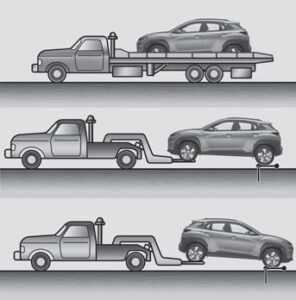
- If towing is required, lift all four wheels off the ground and tow the vehicle. If you must tow the vehicle using only two wheels, lift the front wheels off the ground and tow the vehicle.
If necessary to roll the vehicle so that it can be rolled onto a flatbed tow truck perform the following:- First, depress the brake pedal and release the parking brake.
- While depressing the brake pedal shift to the N (Neutral) position and press the POWER button to turn the vehicle off.
- Wait 3 minutes or more before opening the driver door and the vehicle will remain in ACC mode and in Neutral.
- If the driver door is opened within the 3 minutes, the vehicle will automatically shift to P (Park), the vehicle will turn OFF and the front wheels will be remained locked.

- If you tow the vehicle while the front wheels are touching the ground, the vehicle motor may generate electricity and the motor components may be damaged or a fire may occur.
- When a vehicle fire occurs due to the battery, there is a risk of a second fire. Contact 911 when towing the vehicle.
Additional Precautions
- When you paint or apply heat treatment to the vehicle as a result of an accident, the performance of the high-voltage battery can be reduced.
If heat treatment is required, contact an authorized HYUNDAI dealer. - When you clean the motor compartment, do not use high-pressure water to wash. This may cause an electric shock due to a discharge in high voltage electricity, or damage the vehicle’s electric system.
- Do not use, remodel, or install non-genuine parts. This may damage the electric power system.
Service Interlock Connector
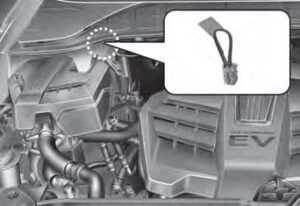
In case of emergency, cut the service interlock connector cable to isolate the high voltage of the battery.
WARNING
Never disconnect the service interlock connector or cut the wire except in an emergency situation.
Serious problems may occur, such as the vehicle will not start.
Service Plug
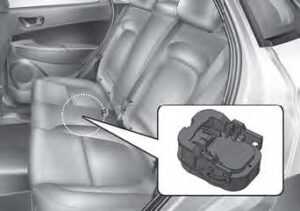
DANGER
Never touch the service plug under the rear seat.
The service plug is attached to the high-voltage battery system.
Touching the service plug will result in death or serious injury.
Service personnel should follow procedures in the service manual.
FAQ
To start a 2023 Hyundai Kona-EV, depress the brake pedal fully and press the START button. The dashboard will illuminate once it is fully started. There will not be any engine sound.
To drive a 2023 Hyundai Kona-EV, simply follow the same steps as you would for any other car. Use the accelerator pedal to increase speed and the brake pedal to slow down or stop. The only difference is that there is no engine noise, so you will need to be more aware of your surroundings.
The EPA estimates that the 2023 Hyundai Kona-EV has a range of 258 miles on a single charge.
The charging time for a 2023 Hyundai Kona-EV depends on the type of charger you use. A Level 1 charger will take about 25 hours to fully charge the battery. A Level 2 charger will take about 9 hours to fully charge the battery, and a DC fast charger can fully charge the battery in about 50 minutes.
You can charge a 2023 Hyundai Kona-EV at any public charging station. There are also many private charging stations available, such as those at workplaces and shopping malls.
The 2023 Hyundai Kona-EV is available in three trim levels: SE, SEL, and Limited. The SE is the base trim level and comes standard with features such as a 10.25-inch touchscreen infotainment system, a rearview camera, and cloth seats. The SEL adds features such as a heated steering wheel, a sunroof, and leatherette seats. The Limited is the top trim level and comes standard with features such as a 12.3-inch digital instrument cluster, a Bose sound system, and heated and ventilated front seats.
The Kona Electric has four driving modes to suit the driver’s needs, which include Eco, Eco+, Comfort and Sport.
EV mode is more particular in its uses than other driving modes such as EVO, Power, Sport, and Snow. If a hybrid is running in EV mode, its only pulling power is coming from its battery. As with purely electric cars, this makes for a more efficient drive.
Clearer vision in dark situations. Headlight bulbs, like LED headlights, HID headlights, or halogen bulbs, are among some of the best bulbs to emit a bright light.
Low beam headlights / dipped headlights
The standard headlamp indicator symbol looks like a sun or upside-down light bulb. On many headlight control dials, there will also be an enclosed circle next to this indicator symbol.
Useful Link
View Full User Guide: Hyundai Kona-EV 2023 User Guide
2023 Hyundai Kona-EV Charge Types for Electric Vehicle
2023 Hyundai Tuscon Specs, Price, Features, Milage (Brochure)

